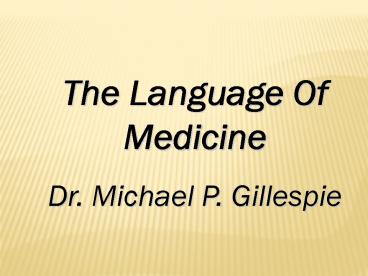Language of Medicine - PowerPoint PPT Presentation
1 / 36
Title: Language of Medicine
1
The Language Of Medicine Dr. Michael P. Gillespie
2
Chapter 19Cancer Medicine (Oncology)
3
Chapter Goals
- Identify medical terms that describe the growth
and spread of tumors. - Recognize terms related to the causes, diagnosis,
and treatment of cancer. - Review how tumors are classified and described by
pathologists.
4
Chapter Goals
- Describe x-ray studies, laboratory tests, and
other procedures used by physicians for
determining the presence and extent of spread
(staging) of tumors. - Apply your new knowledge to understanding medical
terms in their proper contexts, such as medical
reports and records.
5
Introduction
- Cancer characterized by unrestrained and
excessive growth of cells - Malignant tumors compress, invade and destroy
surrounding tissues
6
Cancer
- Cancer is responsible for 20 of all deaths in
the United States. - More than half of people who develop cancer are
cured.
7
QUICK QUIZ
- Which cancers are the most common causes of
cancer death for women? - lung, breast, colorectal
- lung, colorectal, breast
- breast, lung, colorectal
- colorectal, breast, lung
8
QUICK QUIZ
- Which cancers are the most common causes of
cancer death for men? - lung, prostate, colorectal
- lung, colorectal, prostate
- prostate, lung, colorectal
- colorectal, prostate, lung
9
Characteristics of Tumors
Neoplasms (Tumors) growths that arise from
normal tissue
- Malignant
- Multiply rapidly
- Invasive and infiltrative
- Undifferentiated
- Metastasize
- Benign
- Grow slowly
- Encapsulated
- Differentiated
- Dont spread
10
Characteristics of Tumors
11
What Causes Cancer?
- Carcinogenesis transformation of a normal cell
to a cancerous one - Damage to genetic material
- Genes
- Nucleotides
- Mutation
- Apoptosis
- DNA function
- Mitosis
- Protein synthesis
12
Carcinogenesis
- Environmental Agents
- Chemical carcinogens
- Radiation
- Viruses (RNA and DNA)
- Oncogenes (ras/colon cancer, myc/lymphoma, and
bcr-abl/chronic myelogenous leukemia) - Heredity
- Retinoblastoma, polyposis coli
13
Genes Implicated in Hereditary Cancers
14
Classification of Cancerous Tumors
- Carcinomas epithelial cell origin, 90 of all
malignancies are carcinomas
15
Carcinomas and the Epithelial Tissues from Which
They Derive
16
Carcinomas and the Epithelial Tissues from Which
They Derive
17
Classification of Cancerous Tumors
- Sarcomas connective tissue origin, 5 of all
malignancies
18
Sarcomas and the Connective Tissues from Which
They Derive
19
Sarcomas and the Connective Tissues from Which
They Derive
20
Classification of Cancerous Tumors
- Mixed Tissue Tumors tissues capable of
differentiating into epithelial and connective
tissue
21
Pathological DescriptionsGross
- Cystic
- Fungating
- Inflammatory
- Medullary
- Necrotic
- Polypoid
- Ulcerating
- Verrucous
22
Pathological DescriptionsMicroscopic
- Alveolar
- Carcinoma in situ
- Diffuse
- Dysplastic
- Epidermoid
- Follicular
- Nodular
- Papillary
- Pleomorphic
- Scirrhous
- Undifferentiated
23
Grading and Staging of Tumors
- Grade degree of maturity or differentiation
under the microscope - Stage extent of spread in the body
24
International TNM Staging System for Lung Cancer
25
International TNM Staging System for Lung Cancer
26
Cancer Treatment Surgery
- Excisional biopsy
- Exenteration
- Fine needle aspiration biopsy
- Fulguration
- Incisional biopsy
- Cauterization
- Core needle biopsy
- Cryosurgery
- En bloc resection
27
Cancer Treatment Radiation Therapy (Radiation
Oncology)
- Brachytherapy
- Electron beams
- External beam radiation (teletherapy)
- Fields
- Fractionation
- Gray (Gy)
- Linear accelerator
- Photon therapy
- Proton therapy
- Radiocurable tumor
- Radioresistant tumor
- Radiosensitive tumor
- Radiosensitizers
28
Radiation Therapy Side Effects
- Alopecia (baldness)
- Fibrosis (increase in connective tissue)
- Mucositis (inflammation and ulceration of mucous
membranes - Myelosuppression (bone marrow depression)
- Nausea and vomiting
- Pneumonitis
- Xerostomia (dryness of mouth)
29
Chemotherapy, Biological Therapy, and
Differentiating Agents
- Alkylating agents
- Antibiotics
- Antimetabolites
- Antimitotics
- Hormonal agents
30
Cancer Chemotherapeutic Agents and the Cancers
They Treat
31
Cancer Chemotherapeutic Agents and the Cancers
They Treat
32
Mechanisms of Action of Cancer Chemotherapeutic
Agents
33
Biological Agents
- Agents that use or fortify the bodys own
defenses against tumors (e.g, biological response
modifiers/interferon)
34
Combining Forms
Combining Forms
follicul/o fung/i medull/o mucos/o mut/a mutagen/o
onc/o papill/o
pharmac/o plas/o ple/o polyp/o prot/o radi/o sarc/
o scirrh/o xer/o
alveol/o cac/o carcin/o cauter/o chem/o cry/o cyst
/o fibr/o
35
Suffixes Prefixes
- ana-
- apo-
- brachy-
- epi-
- meta-
- tele-
- -blastoma
- -genesis
- -oma
- -plasia
- -plasm
- -suppression
- -therapy
36
Clinical Procedures to Detect or Treat
Malignancies
- Laparoscopy
- Mammography
- MRI
- Needle biopsy
- Radionuclide scans
- Ultrasound
- X-rays
- Bone marrow biopsy
- Bone marrow or stem cell transplant
- CT scans
- Fiberoptic colonoscopy
- Exfoliative cytology

























![READ⚡[PDF]✔ A Companion to the Anthropology of Reproductive Medicine and Technology (Wiley PowerPoint PPT Presentation](https://s3.amazonaws.com/images.powershow.com/10046707.th0.jpg?_=202406030510)




![[PDF] Narrative Medicine: Honoring the Stories of Illness 1st Edition Android PowerPoint PPT Presentation](https://s3.amazonaws.com/images.powershow.com/10082374.th0.jpg?_=20240720089)
